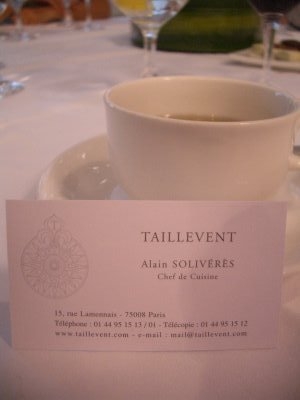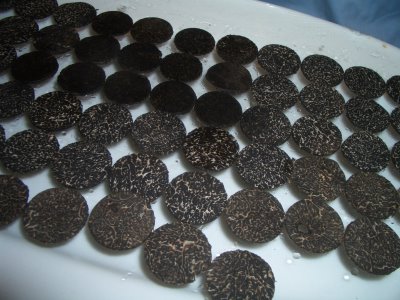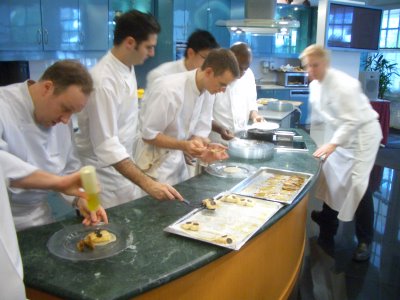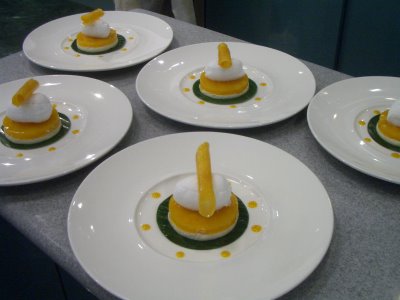Seeing stars, smelling truffles
Spent the most amazing Friday morning last week at the Raffles Culinary Academy, where guest chef Alain Soliveres was hosting a Provencal cooking class as part of the Raffles Hotel's annual Wine, Food & Arts Experience. The class, which included a cooking demonstration as well as a lunch, was a belated Christmas present from Philippe, and I spent the better parts of the two weeks prior giddy with anticipation.
This year marked the 11th anniversary of the Wine, Food & Arts Experience, and Raffles Hotel invited several of Europe's top chefs (with, aptly enough, 11 Michelin stars between them) to grace the festival. Events included Masterchef dinners, wine tastings, cooking classes, a star-studded champagne brunch, and many were fully booked weeks in advance. After much deliberation, we decided to go for the culinary class, thinking that it would allow us to appreciate a specific chef's cuisine more intimately and informally (and also without completely breaking the bank). And given that Philippe grew up in Provence, chef Alain Soliveres' class immediately won out over the others' :)
Here's what the Wine, Food & Arts Experience booklet had to say about Alain Soliveres (sorry, haven't figured out how to type accents, but you can see them from my cut-and-paste below) and his restaurant Taillevent:
Named after a 14th century chef who wrote one of the oldest known books on French cookery, Taillevent, the restaurant helmed by chef Alain Solivérès occupies a 19th century town house off the Champs-Elysées. Heralded with three stars rating for more than thirty years since 1973, this grande dame's success is a result of owner Mr Jean-Claude Vrinat's passionate and zealous attention to detail.
Chef Alain Solivérès, the fifth chef at Taillevent in the forty years that Mr Vrinat has owned the restaurant, is a native from Beziers in the Languedoc region of France. Before holding the reins in the kitchen at Taillevent, Chef Solivérès had trained under masters including Chef Alain Ducasse at Le Louis XV in Monaco and Chef Jacques Maximin in Negresco in Nice. His cuisine is distinctly Provençal, personal and robust, and has won a firm reputation of creating brilliant modern riffs of Southern French classics and tempts accomplished and proficient palates with constant new dishes that reflects his lusty yet refined style.
The class started at 10am on Friday. Upon our arrival, we were greeted by the perpetually smiling staff of the Culinary Academy and handed our menu for the day:
Spelt Risotto, Sliced Black Winter Truffle
Poached Brittany Seabass, Shaved Truffle Caramelized Endives
Baked Ginger Snow Egg & Mango Jelly
After some quick introductions, Chef Alain began preparing the dishes... and my life was changed forever... :)
First and foremost, let me say that Chef Alain has to be one of the more pleasant and unassuming people I've ever met, let alone for someone so lauded in the culinary world. With the help of translations by Chef Nicolas of Raffles Grill, he patiently explained not just how each dish was put together, but also talked us through his choice of ingredients, his cooking philosophy, the history of Taillevent, how the kitchen of a 3 Michelin star restaurant is managed, and so on, and even took questions from our class as simple as "how do you choose a good frying pan?"
His humility was only rivalled by the evident love he has for his craft - even when preparing the caramelized endives, a Taillevent staple, he gently lifted each individual endive slice from the frying pan to check if the colour was precisely right. His painstaking attention to each and every component of the meal almost made us students ill with guilt - boiling your chicken broth for 3 hours instead of 6? buying off the shelf, factory refined grain instead of grain from a small-batch farmer you know personally? flipping your fish fillet in the frying pan more than just once? You could almost imagine a tear rolling down chef Alain's cheek at the thought...
This passion clearly echoes through the rest of the Taillevent kitchen - chef Arnaud, the pastry sous chef of Taillevent, similarly chose to remake an entire egg meringue (see photos below) rather than serve us one that had errantly fallen on the side of the plate and suffered a little dent, naked to the normal human eye, but an unforgivable blemish in the eyes of this pastry chef.
One wonderful and unforeseen side benefit of chef Alain's attention to detail came in the form of a statement, made casually and matter-of-factly, at the start of the class:
"I like to work with seasonal ingredients. One ingredient I like to use in winter is truffles, so I thought I'd share these with you today"
Kinda like the Queen of England saying oh, I think sapphires look good on you, would you like to help yourself to some of the Crown Jewels?
This introduction was followed with a short discussion on this year's truffle season and the mechanics of truffle pricing.
Some truffle facts, courtesy of chef Alain:
- Apparently, due to a particularly cold winter in Europe this year, many truffles have frozen over, and there is now an Official Truffle Shortage which has pushed the price of French black truffles to 1,600 Euros a kg!
- Taillevent uses 2kg of truffles a day, with each truffle weighing an average of 60g.
- Nowadays, mainly dogs are used to sniff out truffles, as boar tend to eat the truffle (lucky pigs, pardon the pun).
- Truffles can be found in France, Spain and Italy. Italy is the only source of white truffles, from Alban, which are not cooked but rather simply shaved over rice and pasta. White truffles go for 8,000 Euros a kg. I haven't checked my insurance policies for a while, but I highly suspect I'm not even worth as much.
- When preparing black truffles for cooking, the skin of the truffle is usually removed using a fine peeler. This peeled-off skin is then chopped to produce chopped truffles. The peeled main body truffle is thinly sliced using a mandolin or a truffle slicer. These are the truffle slices usually used to top dishes - they are added to the dish at the final moment in order to retain the maximum perfume.
It was at the end of this little lesson that chef Alain began reaching for the chopped truffles to use in the risotto. Bear in mind, the risotto he'd been preparing was just one person's portion. He literally grabbed an entire fistful of truffles and nonchalantly tossed them into the pan.
The entire room went silent.
And the lady behind me, speaking for the rest of us, just went "Oh. My. God."
That was at 10.15am.
A course-by-course breakdown (don't worry, there were only 3):
Spelt Risotto, Sliced Black Winter Truffle
Spelt is a light brown grain from the rice family that is commonly grown in the south of France, where it is considered "poor man's food". While a quick visit to our local organic store yielded up several varieties of spelt flour, the grain is more elusive in Singapore. Chef Alain was also quite insistent that even if you can find spelt grain, it may not be worth cooking with if it's been factory processed, as much of the flavour is lost during the refining. At Taillevent, only spelt from a particular local farmer is used, and chef Alain purchases 500kg/year of the farmer's total annual production of 600kg.
As testimony to the "naturalness" of his spelt, chef Alain could constantly be found picking out little black specks from the spelt as he stirred it. Yup, the French terroir, the warmth of the Provencal sunshine, the footsteps of generations of French farmers, all captured in that little pan of spelt and lovingly removed by the magical fingers of a 3 Michelin star chef...
The spelt is cooked in a broth of beef bone marrow, shallows, white wine and chicken stock. The preparation time is somewhat lengthy, with the chicken stock being added one scoop at a time and made to reduce almost completely before the next scoop is added. This takes about 25 mins, following which the risotto is topped with butter (40g a person, an instant heart attack), chopped truffles (the aforementioned fistful), chopped spring onions, grated parmesan and whipped cream. Once plated, the risotto is then laced with homemade veal jus and topped with even more sliced truffles, olive oil and fleur de sel.
The end result is nothing short of alchemical, and you understand why this dish has been a Taillevent staple for over 10 years. The risotto itself is surprisingly light - the spelt has a barley-like crunch to it - and the minimal use of cream brings out both the heady perfume of the truffles, the robustness of the natural chicken stock as well as the intense flavour of the veal jus. The contrasts work so well that each bite just fuels your hunger for more, and it literally renders you speechless until the last spoonful is scooped off the plate.
You dig your spoon into the risotto.
You gingerly balance a slice of truffle on top.
You gracefully slide the spoon into your mouth (even though you'd much rather shovel it in with your bare hands).
You wait.
The flavours burst.
You close your eyes.
And the entire universe just ceases to matter.
Until you slowly come to your senses, and realize...
The main course is up next.
.
.
.
(On a side note, as if this dish needed anything to make it better, we were generously served a glass, well several glasses, of a Puligny-Montrachet from Domaine Leflaive, one of the guest vintners for the event. And kudos to this lovely white Burgundy for holding its own against the risotto - this is definitely one wine I'd love to hoard to elevate special dinners. We also had a lovely little amuse-bouche before starting, a gazpacho like cold tomato soup drizzled with basil oil in a martini glass. Here's a pic.)
Poached Brittany Seabass, Shaved Truffle, Caramelized Endives
Like the risotto, chef Alain's poached seabass is not a complicated nor difficult dish, just one that demands the freshest and best ingredients, and plenty of love in the preparation (feel the love!)
That's chef Alain on the left with the squeeze bottle. I'm guessing the other chefs are a visiting boyband in disguise.
The endives (also a winter vegetable - substitute with asparagus in the spring, artichokes, tomatoes or basil in the summer and wild mushrooms in autumn) were used in two ways on this dish. Large endives leaves were sauteed in butter, chopped truffles and chicken stock, then blended to produce a light foamy sauce for the fish. Baby endive halves were caramelized in butter and sugar, then deglazed with some chicken stock for a gorgeous, golden brown, crunchy and bittersweet side. As for the seabass, in keeping with chef Alain's philosophy of using only two or three key flavours per dish, it was simply poached in butter and fleur de sel, then topped with more sliced truffles.
Where the risotto was sinful in its richness and perfume, the seabass was light and even refreshing - the simple, clean cut flavours balancing each other perfectly on every bite.
Again the audience ooh-ed. Again the audience ahh-ed. No-one cared that this elegant dish concealed practically half a stick of butter per individual portion. The road to an early grave never looked so appealing...
This dish was also paired with a lovely wine - a gloriously intense and spicy Cabernet Sauvignon from Sassicaia in Tuscany. While we were concerned that the intensity of the wine might overwhelm the delicate flavours of the fish, it certainly made for very enjoyable drinking after and through dessert. A lady at my table was so smitten by the wine (and rightly so) that she tried to purchase some bottles on the spot, only to be gently rebuffed by the service staff who replied that it was only available at Raffles Grill. As if anyone needed another reason to eat at Raffles Grill! We were also treated to a little introduction by Mr Sebastiano Rossa of Sassicaia on the history of the vineyard and the wine.
Finally, dessert...
Baked Ginger Snow Egg & Mango Jelly
Due to some confusion over the menu, it turns out that dessert was neither baked nor did it contain ginger. Not like anyone cared, this was a luscious dish as beautiful to the eyes as it was on the palate.
Our instructor for this amazing dessert was chef Arnaud, the pastry sous chef at Taillevent. While less lyrical and effervescent as chef Alain, he impressed with his quiet confidence and sure hand, which made what would undoubtedly be a massive kitchen nightmare at home seem easily achievable for the average kitchen dummy. (But we know better, anyone who wants to attempt this better have at least (i) three days spare, (ii) two kitchen helpers, (iii) a heap of patience and (iv) a personal prayer from the Pope.)
Chef Arnaud in the centre and chef Nicolas standing behind him
The circular base of the dessert consists of two layers - the upper diced mango cubes set in homemade mango jelly, and the lower a gelatinized fromage blanc mixture so studded with fresh ground vanilla that it almost looked more brown than white.
(It was at this point that Philippe sniffed, "does he know that mango pudding is on every restaurant menu in Singapore?")
And right on cue, chef Arnaud proceeded to demonstrate why this was no ordinary mango pudding. He filled a large round cookie cutter with a stiff, yet uncooked egg meringue mixture, popped the now round meringue disc into a pot of hot water and poached it to make what looked like an enormous marshmallow. When it cooled, he then scooped at a smooth, ovalesque spoonful and set it carefully aside.
Using the tiniest of knives that would have made Willy Wonka proud, he then sliced off the top of the scooped meringue, dug out a little hole (what I would've given to lick the spoon there and then!), then piped fresh mango puree into the empty space and replaced the top. With what I can only describe as the loving hand of a painter, he then proceeded to painstakingly blend the edges of the meringue with a knife to perfect smoothness.
It takes you a couple of seconds to recover your breath and realize that the man has just made a fake egg.
The egg is then gently brought to nest on the mango-fromage blanc disc, where it sits nervously, knowing that the same chef who patiently brought it to life would unhesitatingly chuck it away should it so much as wobble and sustain a blemish.
The dish is finally top with a roll of dried mango that has been baked overnight at 60 degrees Celsius and decorated with drops of mango puree.
When we finally got to dig our spoons into these little masterpieces, the first realization is how simple the flavours are - fresh, sweet-yet-sour mango against sweet vanilla and airy meringue. But again, the quality of the ingredients and the precise cooking process made all the difference.
Surprisingly, the star of the dish for me though, was the dried mango roll. Although it only received a passing mention during the final plating, it was evident the use of fresh mango, slowly baked, allowed the roll to intensify the tartness of the mango, while retaining sufficient moisture. The end result was therefore not the tough and fibrous dried mango available in the local snack shops here, but rather a sophisticated and sensuous slice of the natural. I'm not sure when I'll attempt a meringue egg (I definitely lack an acrobat or professional pastry chef's dexterity), but I will definitely start churning out these mango rolls as a topping or base for future desserts.
 Our meal was finally concluded by a visit from chef Alain, who seemed genuinely embarassed and almost perplexed by the superlatives being showered upon him. I guess the site of ecstatic foodies high on truffles can be pretty disconcerting. After a lengthy chat, our table was left on its own. The licked-clean plates and emptied wine glasses now only bore faint echoes of the magical encounter we just experienced. The staff were busy packing up.
Our meal was finally concluded by a visit from chef Alain, who seemed genuinely embarassed and almost perplexed by the superlatives being showered upon him. I guess the site of ecstatic foodies high on truffles can be pretty disconcerting. After a lengthy chat, our table was left on its own. The licked-clean plates and emptied wine glasses now only bore faint echoes of the magical encounter we just experienced. The staff were busy packing up.
A sigh.
A last lingering look.
We put down our napkins.
And it was over.
.
.
.
Sigh.













2 Comments:
Great shots! I love the truffle extravaganza...
Just being curious, can I ask what hinata means? We have the same word in Japanese means 'sunny place' :)
By Anonymous, At
7:28 AM
Anonymous, At
7:28 AM
Keiko, thanks! My little point-and-click camera fortunately performs pretty well under bright light, but terribly under any other circumstance, so it was a lucky day :)
Yeah, I got the name Hinata from a Japanese arcade game I used to love to play - Hinata was my favourite character - plus it sounded so cheery :) Since then, I've almost always used it on the 'net... my real name's pretty fun too though, my parents named me Sam after the witch in Bewitched :)
Btw, really love your blog!!! You have an amazing ability to make everything look stunning and yummy!
By hinata, At
11:25 AM
hinata, At
11:25 AM
Post a Comment
Subscribe to Post Comments [Atom]